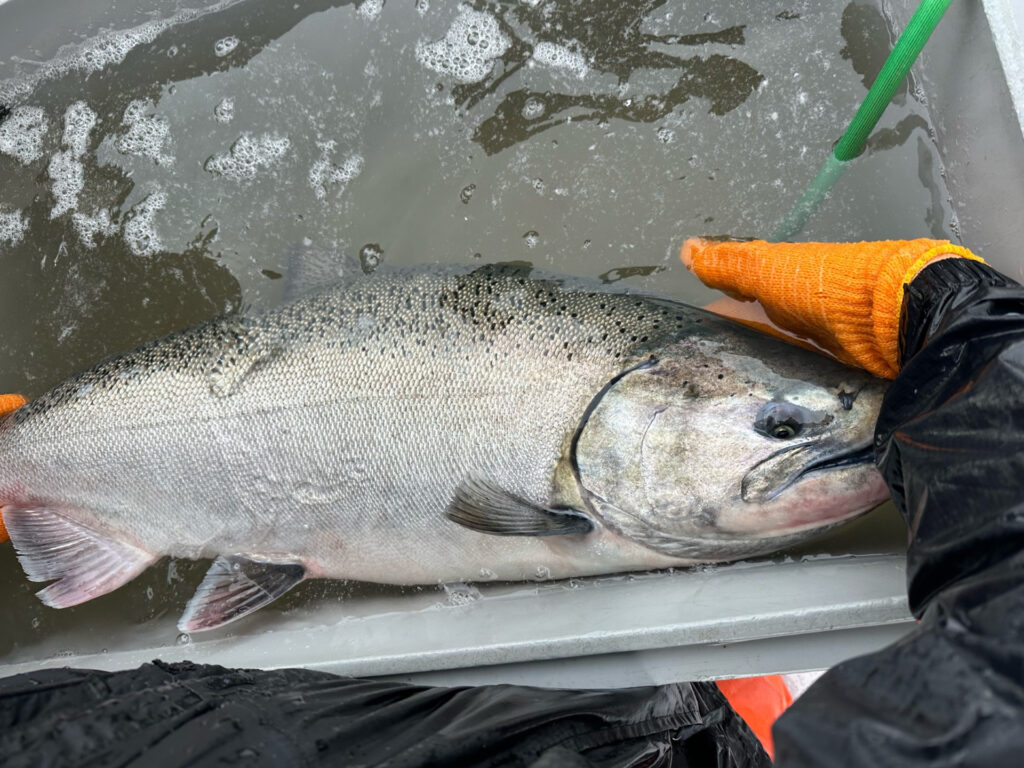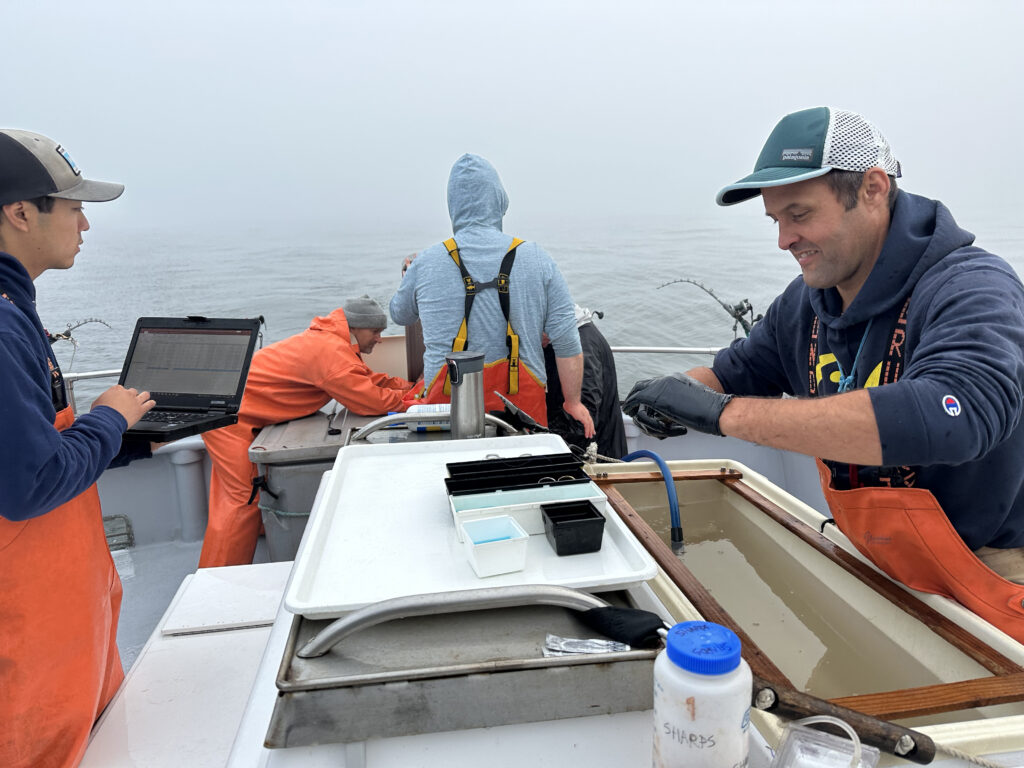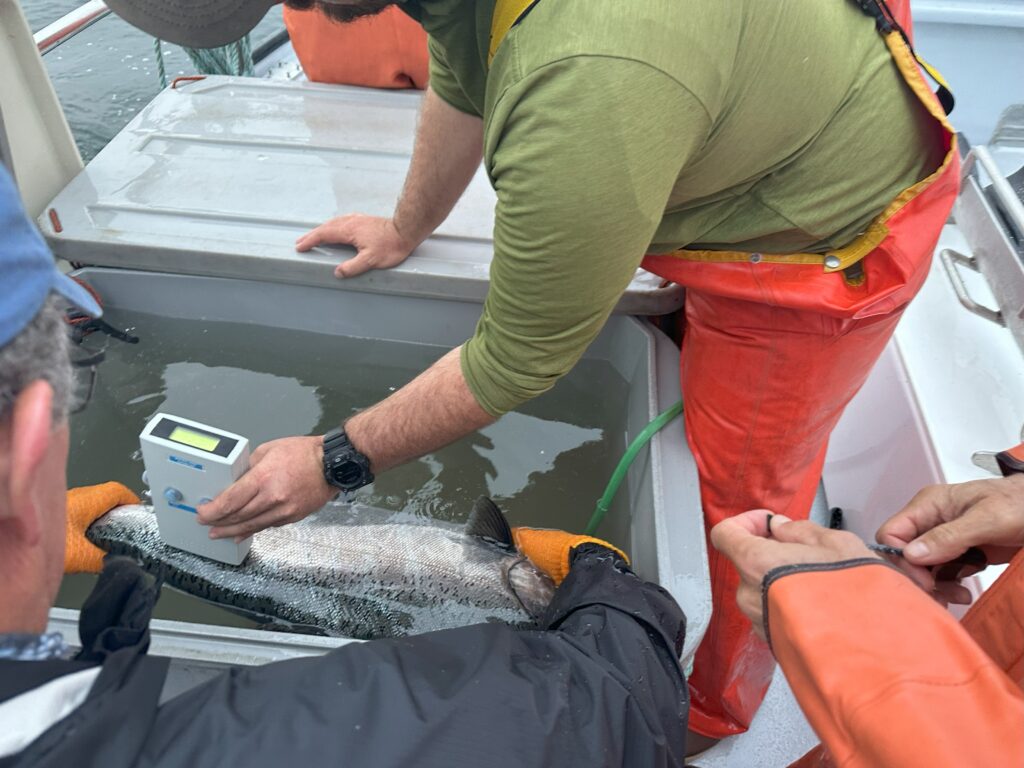Golden State Salmon Association Joins Chinook Salmon Acoustic Telemetry Project in California’s Central Valley by Cat Kaiser [updated September 24, 2023]
Monday, August 21st, a couple of melatonin gummies, 2:30 a.m. and 2:47 a.m. alarms set, gear packed, French press prepped, weather checked, and I was off to bed at 6:30pm. The anxiousness, excitement, and curiosity made it a little tricky to fall asleep, as it was the first time this year I was going salmon fishing in the morning. This was no ordinary salmon fishing trip, though. This was a catch-and-release tagging project for research during the closed salmon season and an opportunity of a lifetime.
First, I would be fishing on the New Rayann with Captain Johnny (Fresh) Atkinson, and I knew if there was only one boat out there looking for salmon, this was the boat that was going to find them.
Second, and most importantly, this fishing trip was day five of a six day study and research project. This study, per the NOAA tracking link, https://rb.gy/mncbv is “The first acoustic telemetry project in California’s Central Valley specifically focused on understanding the relationship between water temperatures and migration of adult Chinook salmon. Conducted by University of California – Santa Cruz, in affiliation with NMFS – Southwest Fisheries Science Center, and with funding from the CA Water Resources Control Board, this study intended to inform potential water temperature targets to ensure successful migration of adult Chinook salmon through the Central Valley watershed.”
“I’m participating in this study to bring the fishery back to what it once was,” said Captain Johnny.
I promptly left Santa Rosa on Tuesday at 3:45 a.m. and drove to Sausalito, rocking out to the Grateful Dead, thinking about how much I was going to learn and experience, and completely forgetting about my unsuccessful eight hours of sleep. I was wide awake. The idea of catching a salmon seemed foreign, and I felt like the luckiest gal in California.
In the dark parking lot at 4:30 a.m. I met five members of the NOAA Fisheries Biophysical Ecology Team all decked out in Grundens and XtraTufs, including Assistant Project Scientist Cyril Michel, who has made the Acoustic Tracking of Juvenile Salmon Project his passion and career.

We were welcomed aboard the New Rayann by Captain Johnny Fresh, deckhand Matt Blaney, and eight other eager fishermen, including boat captains, hatchery managers, and industry folks for a day of education, “flat calm,” sunny weather, and some fun. As we went under the Golden Gate Bridge with trays of anchovies and flashers on the bait table and lead weights in the cup holders, all the fond memories of salmon fishing came flashing back.
The boat scene and energy were different than usual. Scalpels, medical scissors, coded tags, and sanitizing cups replaced the traditional tackle boxes and coolers. The typical wide-open fighting deck had two giant holding tanks filled with water and oxygen pumps. The benches had big coolers of water set up to do the tagging surgery, with a table of tools and a washing station in between. The passengers were there for salmon conservation and a learning experience, not to take home dinner. I can’t say I’ve seen many folks on the average fishing trip with a laptop out the whole time either. The ambiance was more like a science lab meets operating room than a salmon fishing vessel. The vibe was remarkable and we were all grateful to be there for research.

Then the boat slowed down on the familiar August fishing grounds, alerting us that it was time to fish. We all ran (okay, maybe I was the only one that ran) to our rods, started counting our pulls, got lines in the water, and “We’re fishin’!” was heard throughout the boat. It was game on and felt like the good ol’ days, only this time, with no pressure to land every fish, catch a limit, or take the perfect trophy fish photo.
As I watched my rod tip, I thought about what I would name my first salmon that got tagged. I mean, I had to catch it first, I guess, but I was optimistic. The NOAA folks were extremely accommodating and almost as excited as I was about naming and following a specific fish; they even offered to make special notes in their records for me.
After trolling for 20 minutes or so, the recognizable signal and sound of a pumping clicker followed by, “Fish, fish!” was alarmed. The first fish was hooked on the stern, not surprisingly by salmon connoisseur and Mokelumne Fish Hatchery manager Bill Smith.
I’ve never seen the whole boat get so excited to watch someone else catch the first fish. This would be the first salmon of the year that a lot of us have seen, and what a sight it was! I was in awe as deckhand Matt carefully scooped a lunker of a salmon into the net. He didn’t let it touch the boat and gracefully lifted it over the rail, straight into the holding tank, where three of the scientists got it out of the net as quickly and gently as possible.

After about a minute and when the fish calmed down a bit, it was clear that each NOAA person had a specific duty. They took turns at the data collection and were all efficient in different areas. Someone had to always hold the fish in place while another used a fish fat meter in four different spots down the salmon’s body to get an overall fat content average and calling out the numbers to the person inputting the data in the laptop. Another scientist then calls out the length (to the fork) and girth measurements to be recorded. The first fish was 87cm X 59cm or about 24 pounds!
After recording the measurements, a small sliver of gill is taken by the very skillful research team to be tested for pathogens. This was a little nerve-racking, as one slip or movement while taking that gill sample could be trouble. No accidents occurred. The fish were then placed in a cradle that had a rubber coating and aloe vera to protect the scales and moved to the surgery station.

Cyril Michel, the surgeon for the day, carefully cut a one-inch incision in the salmon’s belly to insert two different tags.
Acoustic tags and JSATS, per the NOAA Fisheries website, are used to “track different populations of juvenile salmon during their outmigration to the ocean so we can better understand the dynamics in survival, movement, and migration during this life stage in California’s Central Valley. As part of this effort, the detections of acoustically tagged fish within an array of real-time JSATS (Juvenile Salmon Acoustic Telemetry System) receivers can give scientists and resource managers immediate information on survival and movement. Another component of the effort involves using acoustic tagged fish along with hatchery releases of coded wire tagged fish to estimate capture efficiencies of trawl sampling at Sacramento and Chipps Island. The coordinated use of these different methodologies along with genetic assignments of run-type will allow more accurate estimates of population abundance of fish entering and existing in the Delta.”
Immediately after inserting the tags, two to three stitches were tied to close the incision. A skin sample was then taken to test for parent-based tagging (PBT) research (see footnote link for PBT details), and two FLOY tags were then pushed into the salmon’s back to identify the fish caught for the study.
The salmon were then happily released back into the ocean to swim away freely with no idea how excited everyone was to follow their progress.

Then it was my rod that went off. My heart started pounding as my hands gripped my rod while my reel screamed almost as loudly as I did with excitement. I haven’t felt that kind of tug and head shake in quite some time. Everyone cheered and I squealed as Matt netted what was my first salmon of the season. I closely watched every step of the above-mentioned process from start to finish, making sure that my salmon, which I immediately developed a committed relationship with, was catered to with caution and care. As I watched Cyril release my salmon after surgery back into the big blue water and with the morning drive music still stuck in my head, I named the 23lb salmon Stella Blue after a beautiful and seemingly appropriate Grateful Dead song. After that, I caught some more fish and so did everyone else.
Thirty-five total salmon were caught, tagged, and released on that incredible Tuesday. The average weight was an astonishing 23lbs with the biggest one at a hefty 38lbs. The quantity and size of these fish were unreal. We were all in disbelief at the consistency.
Knowing that everyone is doing everything in their power to protect these fish from the time they are hooked to time of release has a completely different emotional impact than when you know they are going to get tossed on the deck and bonked on the head for consumption. We were all happy to leave knowing that we helped in the mission to improve salmon migration data research, not to mention no one had to go home to filet, process, and vacuum seal 50 pounds of salmon after a long day.
On Wednesday, we did it all over again! We used the last 12 tags of the study, and the last fish was released by 9:30am. It was also the day that I caught my biggest catch-and-release salmon ever, a 91cm x 65cm King that decided to run a mile and make me work for him. Because he was the biggest and fought like a famously memetic champ, I named him Chuck Norris.
As of September 24, 2023, 73 of the 131 total salmon tagged in this specific study have made it to Benicia with 41 already in or past Sacramento.
You can follow the progress in real-time below. Keep an eye out for Stella Blue, aka JSAT #FB1B, and Chuck Norris, aka JSAT #FBCD.
Parent-Based Tagging information https://goldenstatesalmon.org/coleman-hatchery-takes-giant-step-to-restore-sac-river-salmon/.
